These artists are keeping the spirit of Ghanaian mobile cinema alive
Ghana’s hand-painted movie posters are now collectable artworks. We meet the artists and dealers involved in this cult scene
Surrounded by a number of round, paint-splattered palettes, Heavy J reaches for his brush and deftly puts the finishing touches to his new masterpiece. The challenge today for one of Ghana’s greatest movie poster artists is to make Goldie Hawn’s hair just the right shade of red. Using a photo of the actress balanced on his knee as reference, he glides his hand across the canvas before leaning back to admire his work. It’s a brilliantly bizarre creation.
Depicting several scenes from 1992 comedy-horror film Death Becomes Her, it features Hawn and co-stars Bruce Willis and Meryl Streep staring ahead, wide-eyed against a backdrop that includes a plunging neckline and lightning bolts. More than just a movie poster, the piece is also a highly collectable work of art. It will now travel from Heavy J’s blue-walled studio at his house in Teshie, near Accra, to a client overseas, as a newfound obsession with hand-painted Ghanaian movie posters gathers momentum across the globe.
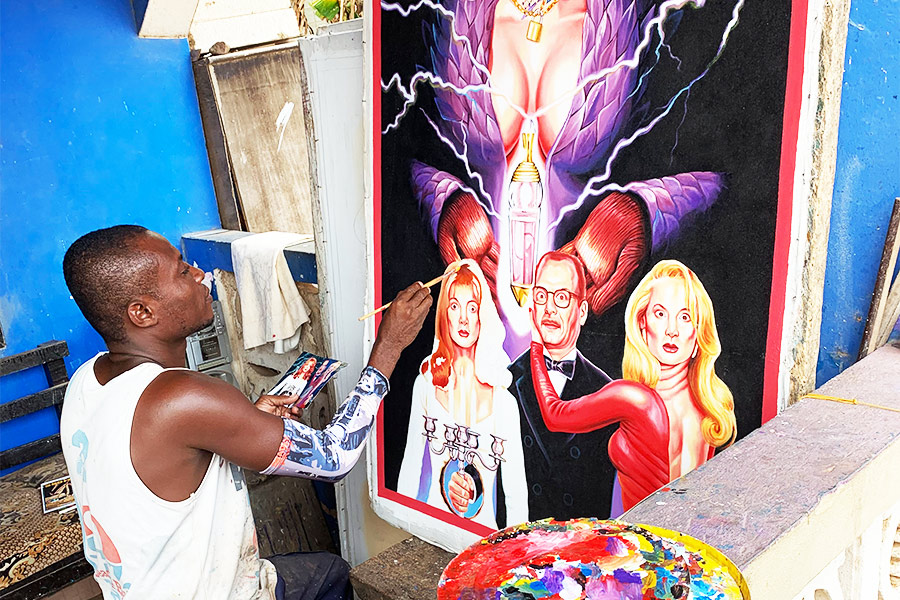
Heavy J painting Death Becomes Her, Ghanaian mobile cinema-style

“Seeing my posters being sold as artworks is a dream come true,” says Heavy J. “Every artist wants to be popular in their field and I’m no different. I certainly didn’t expect this to happen when I started painting, so it feels very good. And, even though I’ve done a lot of posters, I think my best work is yet to come.”
While Ghanaian film posters have become the must-have wall adornment for cinephiles (Quentin Tarantino has three), their initial purpose was far more practical. The unique style that makes the pieces so popular dates back to the late 1980s and the days of Ghanaian ‘mobile cinema’, which saw businesses travelling around the country with a diesel generator, a VCR and TV to screen films (mostly horror, action, low-budget American schlock and Bollywood offerings) for communities in remote areas with no electricity. With these ‘video clubs’ having no access to original movie posters to flag up the cinematic events, they turned to local artists to paint promotional material using stitched-together flour sacks as canvases.
Instead of blindly copying the poster art of Hollywood and Bollywood, painters used artistic license, embellishing scenes from the movie or sometimes adding random, eye-catching elements. A big, red, leaping fish might steal James Bond’s thunder on The Spy Who Loved Me poster, the ever-popular Rambo could invade a Mad Max artwork and Halloween’s Michael Myers might have a cobra wrapped around his neck – all to get punters through the door.
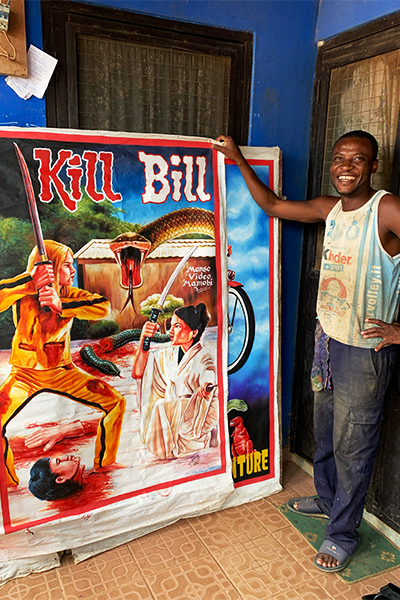
Ninjas, snakes and lots of blood? No problem for Heavy J
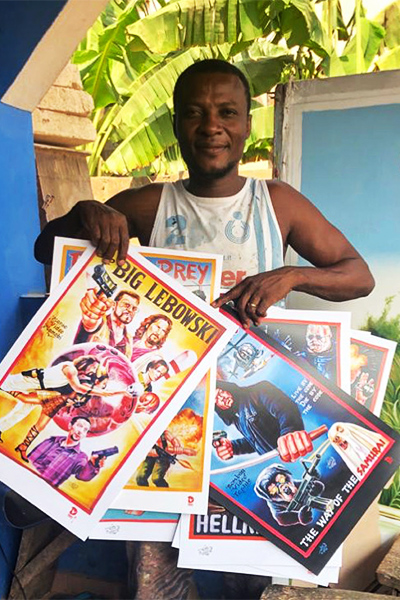
You film it, he can paint it: Heavy J leafs through his Deadly Prey prints
As these video clubs reached their zenith by the 1990s, dozens of poster artists were doing brisk business, often under pseudonyms like Leonardo, Death is Wonder and Heavy J. “The days of the video clubs brings lots of fond memories, like having free entry to watch every movie of your choice and the fame and popularity I gained promoting films across the country,” says Heavy J. “It also brought a lot of happiness to the youth at the time.”
Fellow artist Mr. Nana Agyq recalls the rivalry that existed between the poster brigade back in the day. “I was an apprentice in Heavy J’s shop and everyone wanted to prove himself as the champion,” he says. “I miss how we subjected each other to mockery when you draw something and you don’t get it right. Those video clubs created a lot of employment for the artists and the communities where they operated. It was a good feeling to see your posters travel across the country.”
With home viewing becoming more widespread in Ghana, just about all video clubs have now disappeared. The posters that fuelled them have never been more popular, though, with artists continuing to produce their own barmy take on classic movies for collectors. “We paint to entertain people, regardless of how dull the movie is,” Heavy J points out. “We usually watch the movies and pick some interesting scenes from it and then add our own imagination.”
One of the biggest challenges for artists is coming up with a good likeness of the stars, especially if they are screen icons. “Lesser-known actors are fine, but it becomes difficult when you paint someone like Arnold Schwarzenegger or Sylvester Stallone,” says Mr. Nana Agyq. “You have to take your time to get it right.”
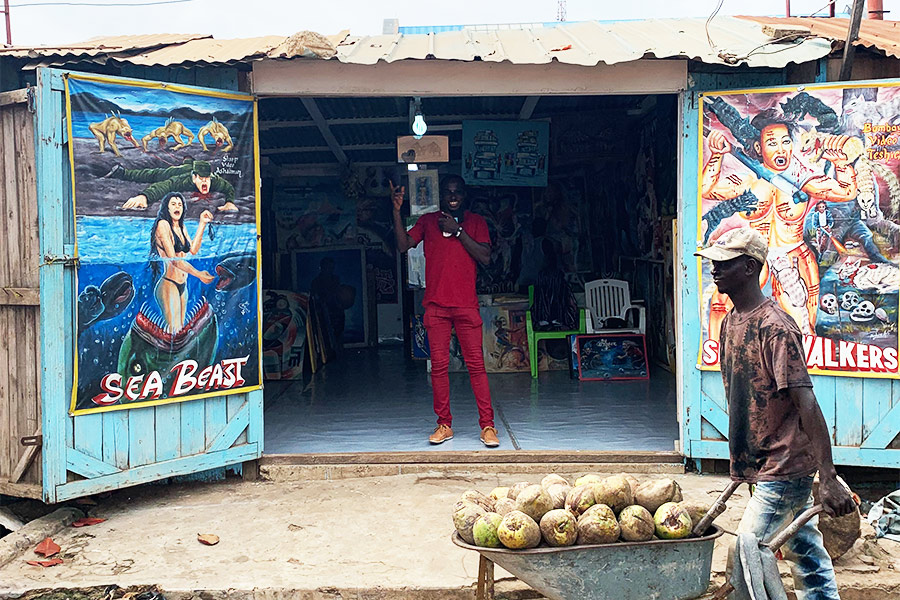
Robert Kofi at his Accra gallery, Ghana Origin

Heavy J and Mr. Nana Agyq are two of ten artists in Ghana who get their commissions through the Chicago-based Deadly Prey Gallery, which has done more than any other art dealer to popularise Ghanaian film posters since opening in 2015. Founded by Brian Chankin and business partner Robert Kofi (owner of the Ghana Origin art gallery in Accra), Deadly Prey allows collectors to pick a movie they want depicted and the best artists to carry out the work. Once the poster is done, the artworks are posted back to Chicago and distributed, with around 60% of the money (prices range from $400-$800) given to the artists. Collectors can also buy prints of the movie posters, with 100% of those profits going to the painters.
Chankin’s love affair with Ghanaian poster art started about 11 years ago, when he was given a book featuring the eye-popping artworks of the mobile cinema era. Scouring the internet for Ghanaian movie posters, Chankin met and befriended Kofi who arranged for some artwork to be sent from Ghana to America. Chankin displayed the posters on the walls of his Chicago video store, Odd Obsession, and it wasn’t long before customers asked if they could purchase them. As demand grew, Chankin and Kofi decided to launch Deadly Prey, aptly naming their gallery after an obscure 1987 action film. Since the doors opened the clientele have grown and evolved. “You obviously have your movie fans and people interested in niche cinema, but we’ve also had a lot of tattoo artists buying artwork,” says Chankin. “And increasingly we have people who want to have album covers done, which is great, because the artists get paid more for commercial work.”
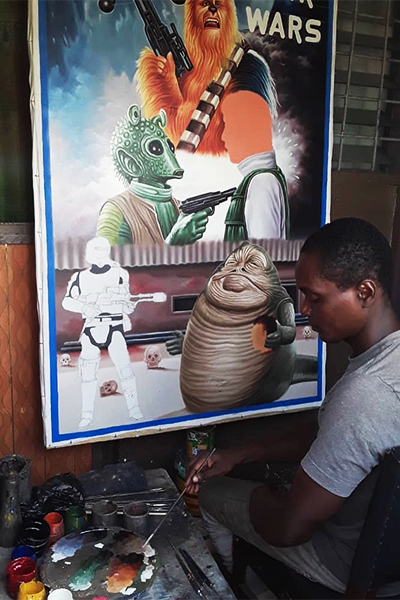
Star Wars through the eyes of Ghanaian artist Mr. Nana Agyq
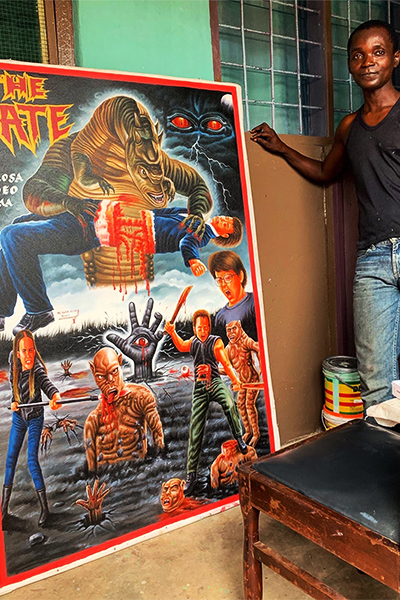
Watch it if you dare: another meticulously crafted B-movie painting by Mr. Nana Agyq
When it comes to Ghanaian film poster art, Deadly Prey not only preserves the present but also the past. The gallery has archived a large number of the early (and hugely valuable) mobile cinema artworks and plans to display them in a museum – either in Chicago or Accra. Or both. “If something is over ten years old, we hang on to it and archive it,” Chankin says. “We want to make sure it’s for everyone to see and not just one person. It’s important to hold on to the past but also keep going with new posters. It’s such a cool artform. It brings back some artistry to movie posters.”
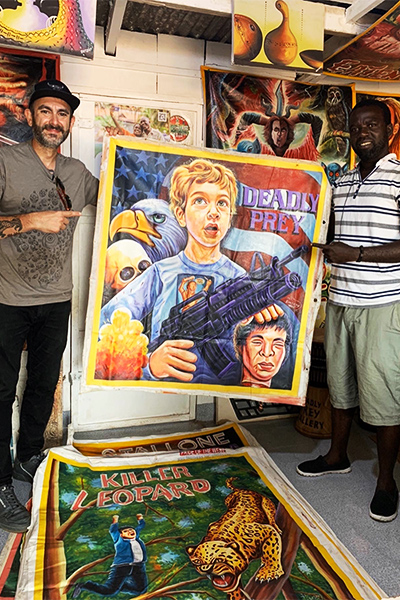
Nii Bi Ashitey and Brian Chankin fly the Deadly Prey flag
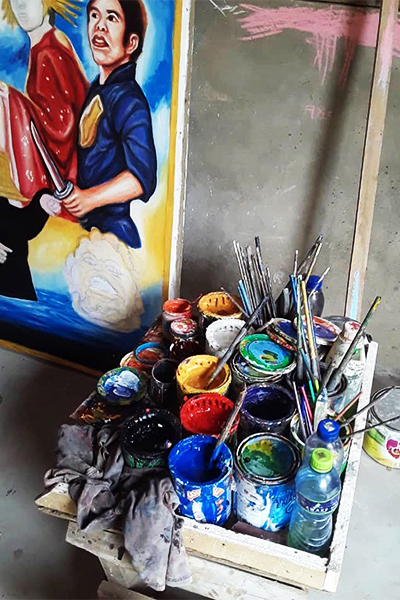
Pots of inspiration at the studio of Ghanaian artist Leonardo
Back in Ghana, the success of Deadly Prey’s artists has rekindled an appreciation for the artform. At Kofi’s gallery in Accra, people drop by to look at the posters and go on a nostalgia trip. “Visitors always go, ‘wow, do these posters still exist?’” Kofi says. “They are so happy to see them and they thank me for keeping the artform alive. It’s becoming popular again and I hope it leads to more people in Ghana taking up painting posters. At the moment, the younger generation don’t really want to spend four years as an apprentice to mature as an artist. There are only a handful of people who want to learn the craft.”
Five of those young talents are over at Heavy J’s studio, where he’s passing along his wealth of knowledge. “The love Ghana has for film spreads across generations,” the artist says. “For us as painters it’s about capturing scenes out of movies people adore and putting it out there. And above all, it’s about painting a beautiful movie poster.”